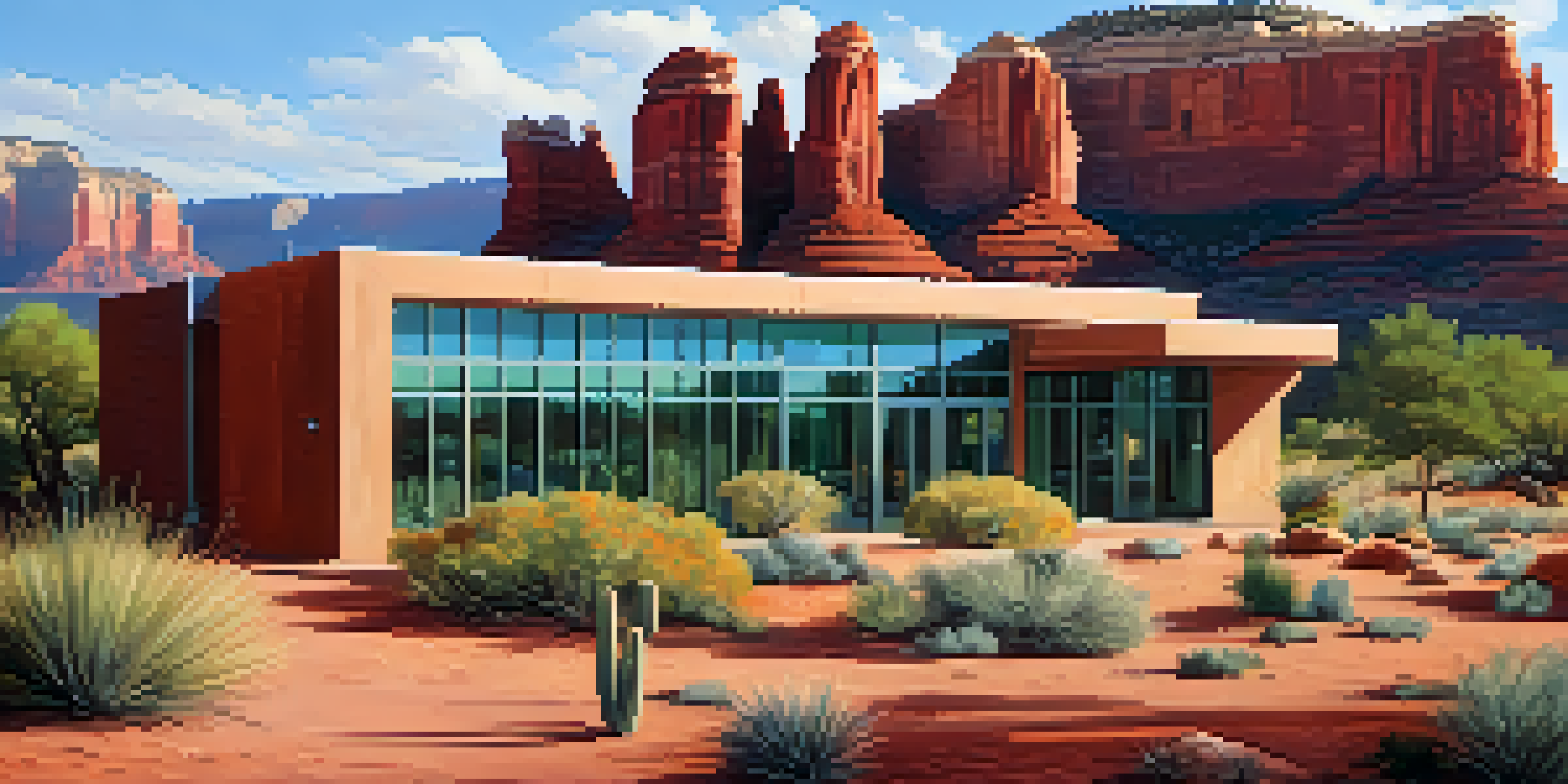Water Conservation Techniques in Sedona's Green Buildings

Understanding the Importance of Water Conservation in Sedona
Sedona, Arizona, known for its stunning red rock formations, faces unique environmental challenges, including water scarcity. With a growing population and increasing tourism, the demand for water is rising, making conservation more crucial than ever. This is where the concept of green buildings comes into play, incorporating sustainability practices that help preserve this precious resource.
Water is the driving force of all nature.
Water conservation not only supports the local ecosystem but also contributes to the overall health of the community. By implementing effective techniques, residents and businesses can reduce their water usage while maintaining comfort and functionality. Understanding the local climate and water resources is essential for adopting these practices effectively.
In this article, we will explore various water conservation techniques that are being integrated into Sedona's green buildings. From rainwater harvesting to xeriscaping, these methods not only promote sustainability but also enhance the beauty of the region.
Rainwater Harvesting: A Sustainable Solution
One of the most effective techniques for conserving water in Sedona is rainwater harvesting. This practice involves collecting and storing rainwater from rooftops, which can then be used for irrigation, landscaping, or even household use. By capturing this natural resource, homeowners can significantly reduce their reliance on the municipal water supply.

Rainwater harvesting systems can be simple or complex, depending on the needs of a building. For instance, a basic system might include a rain barrel connected to a downspout, while more advanced setups can feature filtration systems and underground storage tanks. This flexibility allows homeowners to customize their systems based on available space and budget.
Rainwater Harvesting Benefits
Collecting and storing rainwater can significantly reduce reliance on municipal water supplies while promoting local ecosystem health.
In Sedona's green buildings, rainwater harvesting is becoming increasingly common, demonstrating a commitment to sustainability. By utilizing this technique, residents not only conserve water but also contribute to the health of local waterways, as less runoff means reduced pollution.
Xeriscaping: Designing for Drought-Resistant Landscapes
Xeriscaping is a landscaping technique designed to reduce or eliminate the need for irrigation. By selecting native plants that thrive in Sedona's arid climate, homeowners can create beautiful, low-maintenance gardens that require minimal water. This approach not only conserves water but also promotes biodiversity and supports local wildlife.
The best time to plant a tree was twenty years ago. The second best time is now.
Incorporating xeriscaping into green buildings involves careful planning and design. Homeowners can choose drought-resistant plants, use mulch to retain soil moisture, and design their landscapes to maximize natural rainfall. These choices not only enhance the aesthetics of a property but also reduce water consumption dramatically.
As more Sedona residents embrace xeriscaping, the community is becoming more resilient to water shortages. This technique exemplifies how thoughtful landscaping can contribute to water conservation while celebrating the region's natural beauty.
Efficient Irrigation Systems: Smart Water Usage
Modern irrigation systems are essential for conserving water in green buildings. Drip irrigation, for example, delivers water directly to the plant roots, reducing evaporation and runoff. This method is particularly beneficial in Sedona's dry climate, where every drop counts.
Timers and moisture sensors can further enhance the efficiency of irrigation systems. By automating watering schedules based on actual soil moisture levels, homeowners can prevent overwatering and ensure plants receive the right amount of water. This not only conserves resources but also promotes healthier plant growth.
Xeriscaping for Water Efficiency
Designing drought-resistant landscapes using native plants helps conserve water and enhances the beauty of Sedona.
Adopting efficient irrigation technologies demonstrates a commitment to sustainable practices in Sedona's green buildings. With the right systems in place, residents can enjoy lush landscapes while minimizing their water usage.
Greywater Recycling: Reusing Water Wisely
Greywater recycling is another innovative technique that contributes to water conservation in Sedona's green buildings. This process involves collecting water from sinks, showers, and washing machines, which can then be reused for irrigation or toilet flushing. By recycling greywater, homeowners can significantly reduce their overall water consumption.
Implementing a greywater system requires careful planning and knowledge of local regulations. Homeowners must ensure that the recycled water is safe for its intended use, which often involves filtration and treatment. However, the benefits of reduced water bills and a smaller environmental footprint make it a worthwhile investment.
As more Sedona residents adopt greywater recycling, the community takes a significant step toward sustainability. This technique not only conserves water but also encourages responsible usage, reinforcing the importance of preserving this vital resource.
Water-Efficient Appliances: Saving Water Indoors
In the push for water conservation, water-efficient appliances play a crucial role in green buildings. From low-flow faucets to high-efficiency washing machines, these appliances are designed to use significantly less water without sacrificing performance. By upgrading to water-efficient models, homeowners can make a noticeable impact on their water usage.
For instance, a standard showerhead might use 2.5 gallons per minute, whereas a low-flow showerhead can reduce that to 1.5 gallons. This simple switch can save a family hundreds of gallons of water each year, showcasing how small changes can lead to big savings.
Community Efforts Drive Conservation
Local initiatives and workshops empower Sedona residents to adopt sustainable water-saving practices together.
As Sedona continues to prioritize sustainability, the adoption of water-efficient appliances in green buildings will become increasingly important. These innovations not only support conservation efforts but also promote a culture of responsible resource usage.
Community Initiatives: Promoting Water Conservation
Community initiatives play a vital role in promoting water conservation in Sedona. Local organizations and government agencies often host workshops and events to educate residents about sustainable practices, including water-saving techniques. These resources empower individuals to take action and make informed decisions about their water usage.
Collaborative efforts, such as neighborhood rainwater harvesting programs or xeriscaping challenges, encourage residents to implement conservation techniques together. This sense of community fosters a culture of sustainability, where everyone feels invested in protecting the environment.

By participating in these initiatives, Sedona residents can learn from one another and share successes, creating a ripple effect of positive change. Together, they can ensure that water conservation remains a priority for future generations.
The Future of Water Conservation in Sedona's Green Buildings
Looking ahead, the future of water conservation in Sedona's green buildings is promising. As technology continues to evolve, new innovations will emerge, making it even easier for homeowners to conserve water. From smart home systems that monitor water usage to advanced irrigation technologies, the possibilities are endless.
Additionally, as awareness of climate change and environmental issues grows, more residents are likely to embrace sustainable practices. This shift in mindset will foster a greater commitment to water conservation and inspire further community initiatives.
Ultimately, Sedona's green buildings will serve as a model for other communities seeking to address water scarcity. By prioritizing conservation techniques and embracing innovative solutions, residents can ensure a sustainable future for themselves and the beautiful environment they cherish.